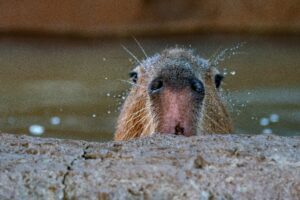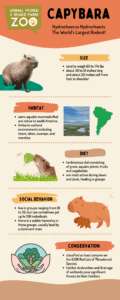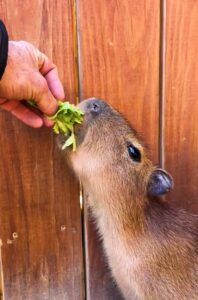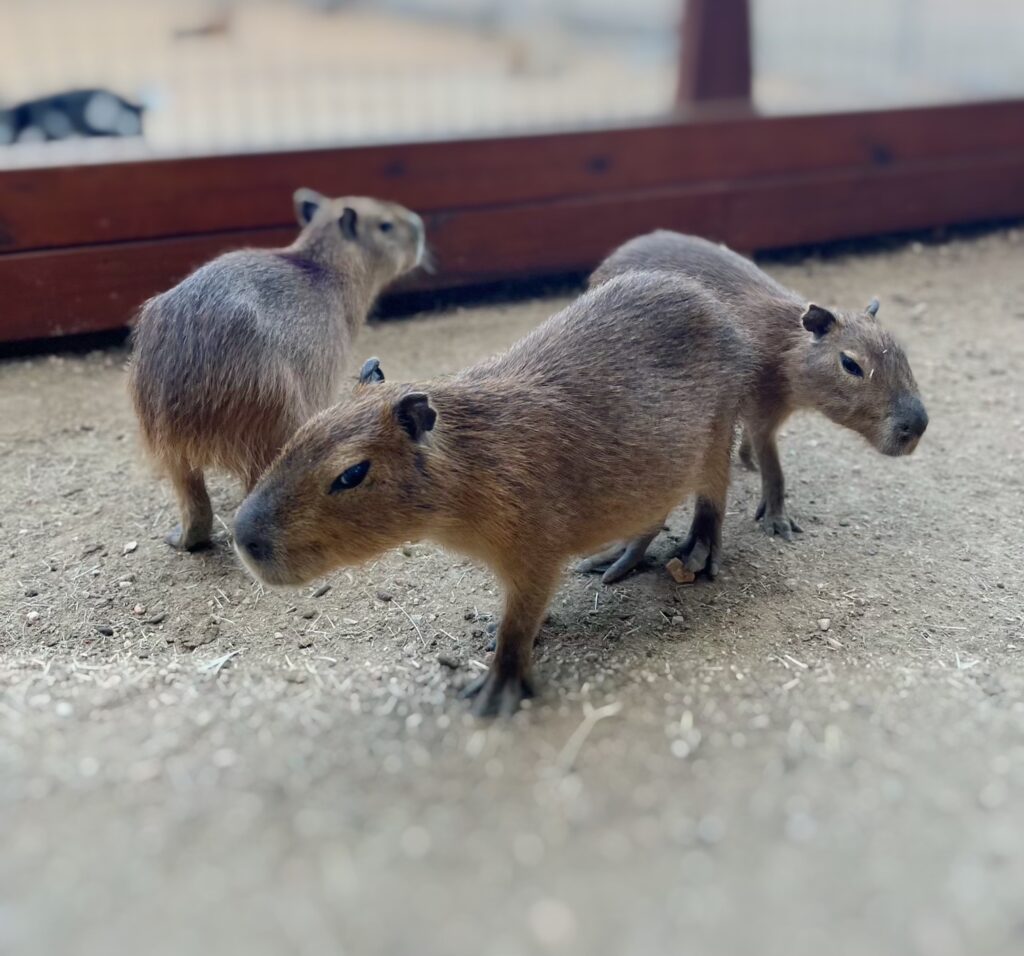Meet The Capybara: Nature’s Gentle Giant
Explore the Capybara Encounter at Animal World and Snake Farm Zoo!
Welcome to an unforgettable experience with the world’s largest rodents—our adorable capybaras, Kiwi, Enzo, and Katy! Capybaras are fascinating creatures native to South America, known for their semi-aquatic lifestyle and social behavior. These gentle giants can be found in a variety of wetland environments, including rivers, lakes, swamps, and marshes, where they play a crucial role in the ecosystem by helping to manage vegetation and water flow. At Animal World and Snake Farm Zoo, we celebrate the capybara, our Animal of the Week, with fun capybara facts and adorable stories about these incredible animals. Join us for a unique close-up encounter where you can feed and pet a capybara, learn about their friendly nature, and discover why the capybara encounter is a must-do for all animal lovers.
Book Your Capybara Encounter Now and experience the charm and wonder of these amazing creatures firsthand!
Understanding Capybaras: Social and Amicable Creatures

Capybaras are not just big; they are incredibly social and thrive in groups. These water-loving animals create strong family units and are known for their calm demeanor and friendly traits. Living in groups that can range from 10 to 20 individuals, but sometimes reaching up to 100, capybaras exhibit a complex social structure with a subtle hierarchy usually led by a dominant male. This social nature is a key part of their survival strategy in the wild, providing protection and cooperation among the group members. Capybaras also form symbiotic relationships with various wildlife, including birds, which help keep them clean and pest-free. These birds, often seen riding on the backs of capybaras, pick off ticks and other parasites, showcasing a unique form of mutualism in nature.
Fun Fact: Did you know capybaras are nicknamed ‘nature’s ottoman’ because of their mutual relationships with birds?

Learn more fascinating capybara facts on our main exhibit page.
The Role of Capybaras in the Ecosystem
Capybaras are valued not only for their gentle nature but also for their role in maintaining ecological balance. Known as “ecosystem engineers,” capybaras help modify their environments to benefit other species. The paths they create in vegetation can regulate water flow and provide new channels for other wildlife, showcasing the importance of capybara size and capybara diet in ecosystem management. Their herbivorous diet, consisting of grasses, aquatic plants, fruits, and vegetables, plays a crucial role in shaping the plant communities in their habitats. By grazing on various plant species, capybaras help maintain the health and diversity of wetland ecosystems. Additionally, their droppings act as a natural fertilizer, enriching the soil and promoting plant growth. Understanding the ecological role of capybaras highlights the interconnectedness of species within an ecosystem and the importance of conserving these unique animals.
Capybara Petting: An Unforgettable Experience
Petting a capybara is an extraordinary and memorable experience at our zoo. Capybaras are known for their docile and friendly nature, which makes them perfect for interactive encounters. Our dedicated zookeepers ensure that all interactions are conducted under careful supervision to guarantee the safety of both our guests and our capybaras. This unique encounter allows you to get up close with these fascinating animals in a controlled and safe environment, highlighting the joy and wonder of connecting with nature. During the capybara encounter, visitors can observe the social behaviors of capybaras firsthand, learn about their dietary habits, and even participate in feeding sessions. This hands-on experience provides a deeper understanding of capybara facts and fosters a greater appreciation for these gentle giants. Whether you’re an animal lover or simply looking for a unique activity, Capybara petting is an experience you won’t want to miss.
Secure Your Spot to Pet a Capybara

Capybara Conservation Status and Efforts
While capybaras are classified as “Least Concern” on the IUCN Red List of Threatened Species, they still face several environmental threats that necessitate conservation efforts. Habitat destruction and the drainage of wetlands pose significant risks to capybara populations. As human activities encroach upon their natural habitats, it’s essential to promote conservation measures to protect these unique animals. At Animal World and Snake Farm Zoo, we are committed to raising awareness about capybara conservation. Through our educational programs and interactive capybara encounters, we aim to highlight the importance of preserving wetland ecosystems. Together, we can ensure that future generations will continue to enjoy and learn about these incredible creatures.
Visit Us and Share Your Experience
We love it when you share your capybara encounter experiences! After your visit, remember to tag us in your photos and stories on social media. Your interactions help raise awareness about animal conservation and support our efforts to provide a haven for these amazing animals. By sharing your experiences, you can inspire others to learn about and appreciate capybaras. Whether it’s a snapshot of you petting a capybara or a fun fact you discovered during your visit, every share helps spread the word about the importance of wildlife conservation. Plan your visit now and create lasting memories with Kiwi, Enzo, and Katy. We’re excited to welcome you to an adventure you’ll cherish forever! Don’t forget to check out our website for more capybara facts and to book your capybara encounter. Your support makes a significant difference in our conservation efforts and helps us continue to provide exceptional care for our animals.

